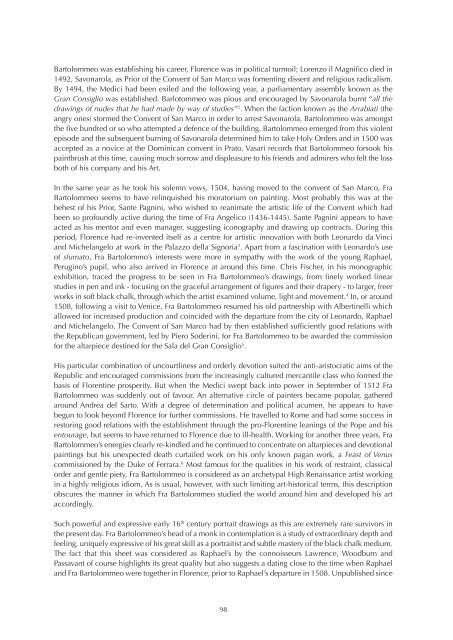Catalogue-2014-Jean-Luc-Baroni
- No tags were found...
You also want an ePaper? Increase the reach of your titles
YUMPU automatically turns print PDFs into web optimized ePapers that Google loves.
Bartolommeo was establishing his career, Florence was in political turmoil; Lorenzo il Magnifico died in<br />
1492, Savonarola, as Prior of the Convent of San Marco was fomenting dissent and religious radicalism.<br />
By 1494, the Medici had been exiled and the following year, a parliamentary assembly known as the<br />
Gran Consiglio was established. Barlotommeo was pious and encouraged by Savonarola burnt “all the<br />
drawings of nudes that he had made by way of studies” 2 . When the faction known as the Arrabiati (the<br />
angry ones) stormed the Convent of San Marco in order to arrest Savonarola, Bartolommeo was amongst<br />
the five hundred or so who attempted a defence of the building. Bartolommeo emerged from this violent<br />
episode and the subsequent burning of Savonarola determined him to take Holy Orders and in 1500 was<br />
accepted as a novice at the Dominican convent in Prato. Vasari records that Bartolommeo forsook his<br />
paintbrush at this time, causing much sorrow and displeasure to his friends and admirers who felt the loss<br />
both of his company and his Art.<br />
In the same year as he took his solemn vows, 1504, having moved to the convent of San Marco, Fra<br />
Bartolommeo seems to have relinquished his moratorium on painting. Most probably this was at the<br />
behest of his Prior, Sante Pagnini, who wished to reanimate the artistic life of the Convent which had<br />
been so profoundly active during the time of Fra Angelico (1436-1445). Sante Pagnini appears to have<br />
acted as his mentor and even manager, suggesting iconography and drawing up contracts. During this<br />
period, Florence had re-invented itself as a centre for artistic innovation with both Leonardo da Vinci<br />
and Michelangelo at work in the Palazzo della Signoria 3 . Apart from a fascination with Leonardo’s use<br />
of sfumato, Fra Bartolommo’s interests were more in sympathy with the work of the young Raphael,<br />
Perugino’s pupil, who also arrived in Florence at around this time. Chris Fischer, in his monographic<br />
exhibition, traced the progress to be seen in Fra Bartolommeo’s drawings, from finely worked linear<br />
studies in pen and ink - focusing on the graceful arrangement of figures and their drapery - to larger, freer<br />
works in soft black chalk, through which the artist examined volume, light and movement. 4 In, or around<br />
1508, following a visit to Venice, Fra Bartolommeo resumed his old partnership with Albertinelli which<br />
allowed for increased production and coincided with the departure from the city of Leonardo, Raphael<br />
and Michelangelo. The Convent of San Marco had by then established sufficiently good relations with<br />
the Republican government, led by Piero Soderini, for Fra Bartolommeo to be awarded the commission<br />
for the altarpiece destined for the Sala del Gran Consiglio 5 .<br />
His particular combination of uncourtliness and orderly devotion suited the anti-aristocratic aims of the<br />
Republic and encouraged commissions from the increasingly cultured mercantile class who formed the<br />
basis of Florentine prosperity. But when the Medici swept back into power in September of 1512 Fra<br />
Bartolommeo was suddenly out of favour. An alternative circle of painters became popular, gathered<br />
around Andrea del Sarto. With a degree of determination and political acumen, he appears to have<br />
begun to look beyond Florence for further commissions. He travelled to Rome and had some success in<br />
restoring good relations with the establishment through the pro-Florentine leanings of the Pope and his<br />
entourage, but seems to have returned to Florence due to ill-health. Working for another three years, Fra<br />
Bartolommeo’s energies clearly re-kindled and he continued to concentrate on altarpieces and devotional<br />
paintings but his unexpected death curtailed work on his only known pagan work, a Feast of Venus<br />
commissioned by the Duke of Ferrara. 6 Most famous for the qualities in his work of restraint, classical<br />
order and gentle piety, Fra Bartolommeo is considered as an archetypal High Renaissance artist working<br />
in a highly religious idiom. As is usual, however, with such limiting art-historical terms, this description<br />
obscures the manner in which Fra Bartolommeo studied the world around him and developed his art<br />
accordingly.<br />
Such powerful and expressive early 16 th century portrait drawings as this are extremely rare survivors in<br />
the present day. Fra Bartolommeo’s head of a monk in contemplation is a study of extraordinary depth and<br />
feeling, uniquely expressive of his great skill as a portraitist and subtle mastery of the black chalk medium.<br />
The fact that this sheet was considered as Raphael’s by the connoisseurs Lawrence, Woodburn and<br />
Passavant of course highlights its great quality but also suggests a dating close to the time when Raphael<br />
and Fra Bartolommeo were together in Florence, prior to Raphael’s departure in 1508. Unpublished since<br />
98
















